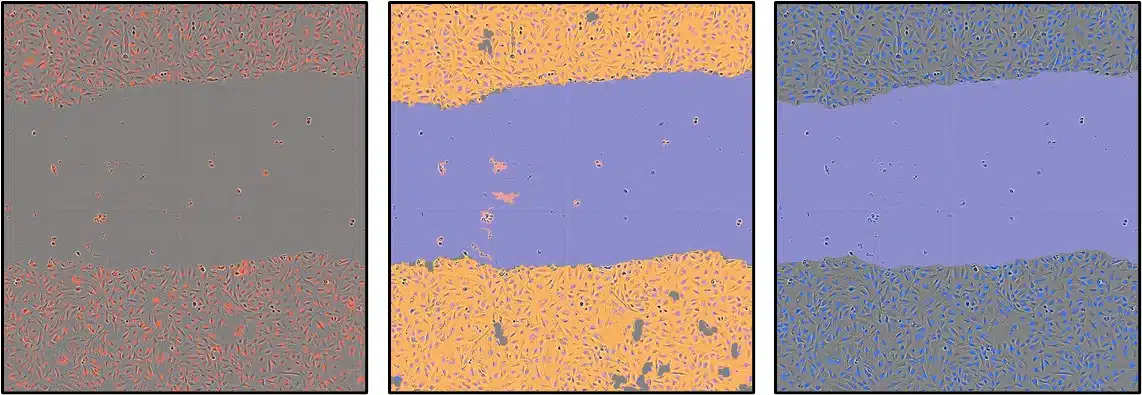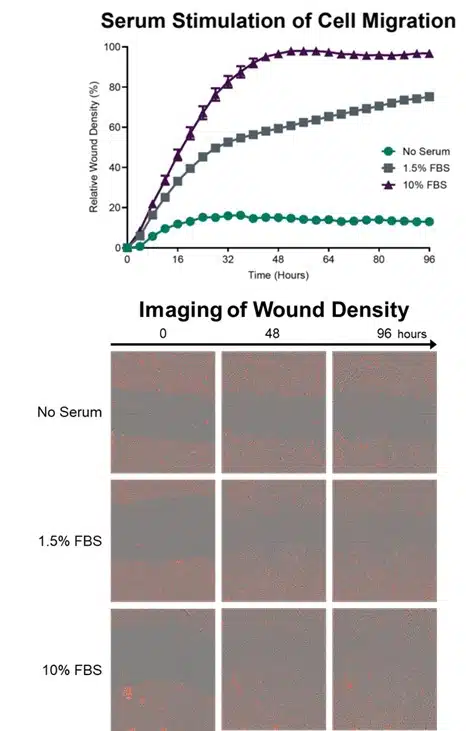
Chemotaxis assays utilizing a modified Boyden chamber assess the motility of cells by quantitating their migration toward a chemoattractant gradient.
Sensitive and Reproducible
Our cell migration assays achieve reproducible, sensitive readouts of migration rate.
Paired Cell Microscopy
All of our cell migration assays can be accompanied by microscope imaging of cells to provide detailed assay images.
Custom ECM Coatings
Variable extracellular matrix coatings can be incorporated into chemotaxis assays to model integrin-mediated cell migration.
Disease-Relevant Results
Cell migration assays are used to model immune response, cancer metastasis, and other migration-dependent clinical conditions.
Kinetic Readouts
Both the scratch wound assay and chemotaxis assay are analyzed by kinetic reads, yielding high resolution and superior accuracy.
Robust and Customizable Assay Conditions
Our expert scientists and advanced instrumentation can create a superior assay for your research needs.
Scratch wound assays and chemotaxis assays can be monitored by automated microscopy, providing images to accompany migration data.
Our modified Boyden chemotaxis assay requires fewer cells than the traditional apparatus. For experiments with primary cells, this means additional experimental conditions per cell isolation.
Our team of scientists will modify cell migration assay workflows to meet your requirements. Cell types, treatments, and assay conditions can be customized to accommodate your needs.
Both the scratch wound assay and chemotaxis assay can be used with a variety of cell types, including primary or immortalized cells.
Our chemotaxis assay allows for longer time courses than traditional Boyden chamber assays. Longer experiments increase the opportunity to observe significant effects.
Advanced Imaging for Accurate Measurements

Our cell migration assays are quantitated by automated high-resolution microscopy. By imaging the exact same field at each timepoint and utilizing automated masking and density calculations, our workflow achieves the highest sensitivity. This method can resolve slight differences in cell migration activity to provide you with the most accurate results
Superior Tools Deliver Better Results

Advanced Image Analysis Provides Superior Quantitation
Our cell migration assay imaging utilizes state-of-the-art spinning disc confocal imaging, with automated analysis and quantitation for precise and sensitive measurement.

Cell Migration Assays Measure Inhibition or Enhancement of Migration
Our cell migration assays are sensitive enough to detect increases or decreases in migration rate, enabling evaluation of a variety of treatments.
Featured Capabilities / Case Studies
Frequently Asked Questions
Need more information on our cell migration assays? Read below, or contact us for answers.
In the scratch wound assay, cells are grown to confluence, then a pipette is dragged across the monolayer to create a gap. Cells are imaged over time to measure the rate at which they fill in the gap.
A Boyden chamber assay consists of two chambers separated by a permeable barrier. Migration of cells from the upper chamber to the lower chemoattractant-containing reservoir provides a measure of cell chemotaxis.
Our cell migration assays achieve reproducible, sensitive readouts of migration rate, and are accompanied by high content imaging of cell monolayers to provide detailed assay images.
Treatments aimed at enhancing or inhibiting migration can be assessed for their effects on cell migration rate.


